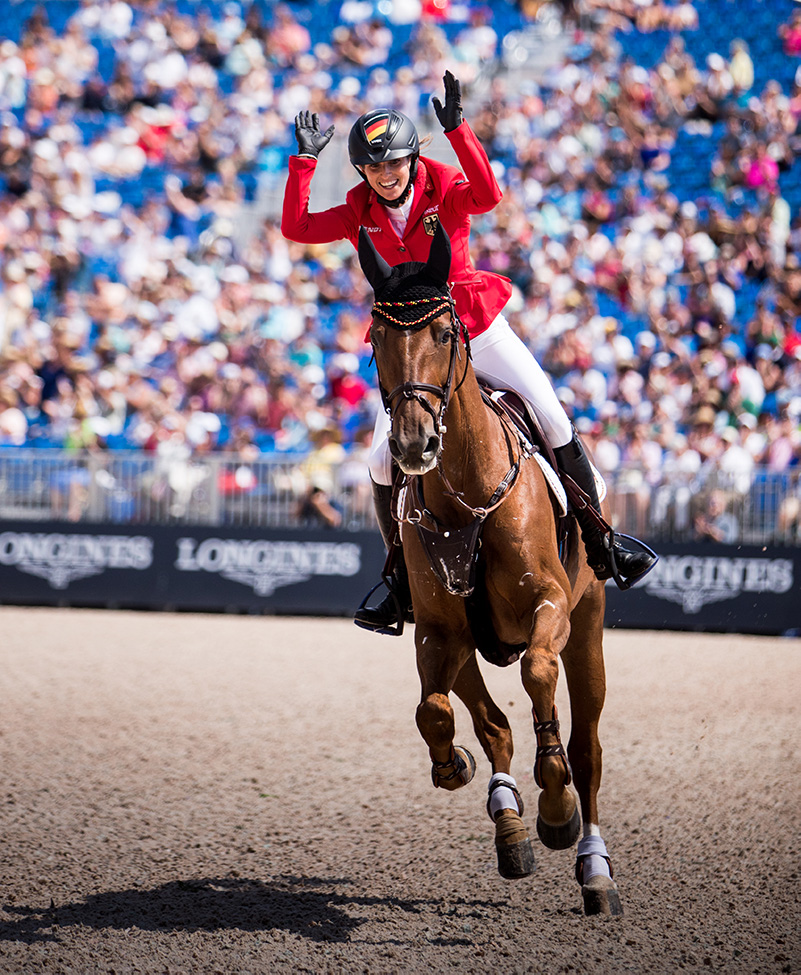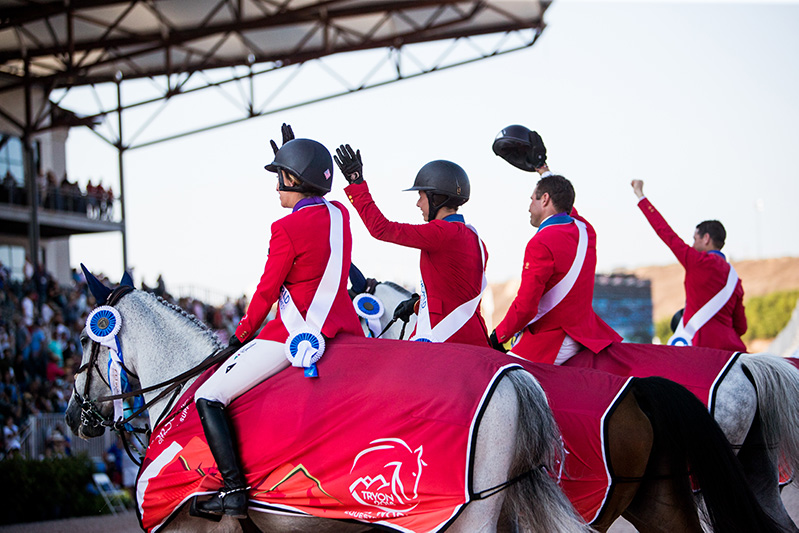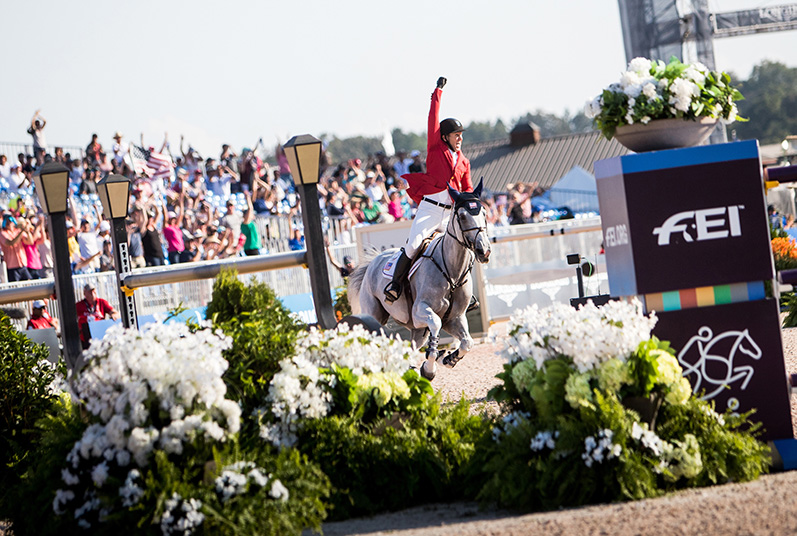Photos by Ashley Neuhof
It was a moment that show jumping fans will remember for a long time. A beautiful, powerful grey mare galloping to a gigantic oxer on the rail, stretching to clear it before streaming through the timers. And, a rider in a pinque coat, punching the air, letting emotions take over in the knowledge that he had secured the team gold medal.
In an improbable situation, the NetJets® U.S. Show Jumping Team finished tied with Sweden after three days of competition at the FEI World Equestrian Games™ Tryon 2018 (WEG). The odds were small that four riders’ total penalties – on two separate teams – would add up to 20.59. But they did, giving spectators one of the most thrilling days of show jumping in recent memory and the home team the chance to stand atop the medal podium.
The Opening Round
It began on Wednesday, September 19, with the opening speed round, held in a faults converted format. In a new format for WEG competition, the first round (with its complicated coefficient/multiplier to calculate penalties from time) counted toward the team score; in previous WEG championships, the opening round only counted toward individual standings and not team scores. Similar to the first day of World Cup™ Final competition, the winner of the opening day speed round received zero penalties while fractions of penalties were given down the list to the 124 other athletes that started on the first day. Those scores would be added to the regular faults given in the “Nations Cup” team rounds on Thursday and Friday. As usual, there was a drop score applied each day for the poorest performing rider on each team.
The starting rider for the U.S. team was Devin Ryan of Long Valley, N.J., and Eddie Blue, a nine-year-old Dutch Warmblood gelding owned by LL Show Jumpers, LLC. WEG marked the pair’s first major games experience and they gave a solid performance fresh out of the gate with just one rail down.
“He felt great out there, he felt confident, he felt solid,” said Ryan of his mount of five years. “It was a blast walking through the ring and having the whole crowd and especially the American crowd, cheering you on. It’s unbelievable when I get on that horse, the confidence that I have in him. I think he believes in me that much, too.”
Another championship rookie, 25-year-old Adrienne Sternlicht of Greenwich, Conn., rode her awe-inspiring mare Cristalline, a 10-year-old Bavarian Warmblood owned by Starlight Farm LLC, to one rail and a slower time.

Laura Kraut and Zeremonie
Olympic team gold medalist Laura Kraut (Wellington, Fla.), riding in her third WEG for the U.S., was paired with Zeremonie, Old Willow Farms LLC’s 11-year-old Holsteiner mare. Experience proved valuable, and Kraut put in the first clear round for the U.S. team, her fast time placing her 12th individually after the first day.
Four-time WEG veteran McLain Ward of Brewster, N.Y. rode Clinta, an 11-year-old Oldenburg mare he owns with Sagamore Farm, in the anchor position for the U.S. team. The two-time Olympic team gold medalist piloted Clinta to a clear round for eighth place on opening day.
Ward decided to bring Clinta for her first championship appearance after his top mount, HH Azur, incurred a slight injury following CHIO Aachen in July.
“It was a really hard decision,” acknowledged Ward. “I’d been to that type of championship before with Azur and she performed brilliantly. Clinta is a spectacular talent but had never faced anything like this. While I believed it was always in her to do it, there are always unknowns. I hate unknowns. I like things totally predictable. I think that’s my greatest asset, that I take most of the margin of error out of play and [am] really consistent. We weren’t able to do that in this situation.
“I’ll always have doubts; I think that’s my nature,” he continued. “You lie in bed the night before and wonder, ‘Did I do this right?’ I sometimes don’t have the internal confidence that people think they see expressed on the outside. I’m always questioning if I made the right choice. But when I make a choice, I believe in it in the end. Though I certainly chew on it!”
With the multiplier applied after the first round, the team’s penalties were 3.64 (Ryan), 4.26 (Sternlicht), 1.87 (Kraut), and 1.08 (Ward). Added together, they totaled 6.59 penalties, which put them into fourth place. While some didn’t notice Sweden lurking in seventh place after the first round with 8.59 penalties – the team boasted four Olympic veterans in Fredrik Jönsson, Malin Baryard-Johnsson, Henrik von Eckermann, and 2016 individual silver medalist Peder Fredricson – the powers-that-be for the U.S. team sure took notice.
“I was less concerned with who was ahead of us than I was with who was behind us,” said U.S. Jumping Chef d’Equipe Robert Ridland. “When I saw Sweden eight [penalties] behind us on Thursday, I let everybody know there was a potential tie with Sweden.”
Second Round
As any international show jumping team member will tell you, victory is achieved one day at a time, one round at a time. On Thursday, Ryan and Eddie Blue put a foot in the water for four faults (the first time they ever faulted at the open water) and Sternlicht and Cristalline had a fabulous round with just a single time fault.
Sternlicht noted that after getting the butterflies out of the way on the first day, she returned to the ring ready to contribute.
“I think this Nations Cup format is really where we thrive,” she said. “I really thought about taking every fence one at a time. I think that’s where my time fault came, but I was more focused on jumping a clear round because that was what our team needed.”

Adrienne Sternlicht and Cristalline
Kraut had a more disappointing day to provide the drop score with eight faults due to two slight rubs on course. “The show jumping gods just weren’t with us today,” she conceded.
Like his student Sternlicht, Ward added just one time fault to his individual and the team scores with Clinta, and the U.S. improved their standing to the silver-medal position with 12.59 penalties going into Friday’s final competition. Sweden stood on 20.59 penalties, still lurking in the background.
Third Round
With temperatures in the 90s and high humidity, the world’s top horses and riders returned for their third consecutive day of championship jumping over challenging tracks set by Irish course designer Alan Wade. From the original start list of 25 nations, only the top 10 teams in the standings were invited back to contest Friday’s team final.
Starting out the day’s competition, Ryan and Eddie Blue completed their first round of the day with a four-fault performance. Sternlicht and Cristalline also had four faults, while Kraut and Zeremonie scored an all-important clear round.
“I knew if we were a disaster or [Sweden was], [a jump-off] wouldn’t apply,” remembered Ridland. “We saw them clear and clear and clear; I knew that this was imminent. I knew we were in position to do what we had to do. I was pretty convinced that McLain’s ride would determine if we tied or won outright.”
The Jump-OffThe atmosphere was electric and filled with anticipation…
The second chance came in the jump-off, in which all four riders from each team returned to jump a shortened course. If a tie still remained after the jump-off, the cumulative times of their jump-off rides would determine the gold medal.
The atmosphere was electric and filled with anticipation as Ryan and Eddie Blue entered the arena for the jump-off. They posted a score of zero faults to match Swedish pathfinder von Eckermann on Toveks Mary Lou. However, Ridland had set a very clear strategy for Ryan’s ride.
“I told Devin to go in there to match the clean, but plus two [seconds],” he said. “Devin said, ‘I’ve never done this before.’ I told him to be two seconds slower but to leave the jumps up and that’s what he did. We needed that round so much. He was clear and 1.89 seconds behind [Henrik]. I joked with him as he walked out that he went too fast! It worked out the way we wanted.”
Afterward, Ryan acknowledged the incredible year he has had leading up to WEG. “A lot has changed over the past 12 months for me,” said Ryan, who was also runner-up in the 2018 Longines FEI World Cup™ Jumping Final with Eddie Blue. “It was my breakthrough year. I’ve been working my way up the ranks, building a business, bringing along young horses, and it’s finally paid off a bit. I’ve learned a lot this week. It’s my first real championship and this year is the first year I’ve actually been on a team. This was my third Nations Cup. The team starts with my family, my owners, and all of these guys. It felt good to be able to produce that clean round for the jump-off.”
With that all-important clear round, Ridland knew he could count on his remaining riders to equal faults and make up time, and that’s exactly what they did.
Sternlicht and Cristalline had one rail down for four faults, equaling the four-fault performance of Malin Baryard-Johnsson and H&M Indiana. Kraut and Zeremonie were fast and clear in the jump-off, keeping the U.S. and Sweden tied after a clear round from Fredrik Jönsson and Cold Play.
“Laura was able to go clean and make up the gap [in time] and it left the door open for McLain,” said Ridland.
Once again, it all came down to Ward and Clinta. After Sweden’s anchor, Peder Fredricson and H&M Christian K, were clear in 34.43 seconds, Ward knew what he had to accomplish. He piloted Clinta to a masterful clear round in the fastest time of the day, 32.58 seconds, to win a historic gold medal for the United States. It was the first team gold medal for the U.S. in a world championship since they won in 1986. While faults were equal between the U.S. and Sweden, the cumulative times were 100.67 seconds for the U.S. and 102.73 seconds for Sweden.

Individual Gold went
to Simone Blum (GER)
and DSP Alice
Germany claimed the bronze medal, while the team’s new superstar, Simone Blum riding DSP Alice, grabbed gold on the final day after jumping five astonishing clear rounds through the week. After finishing an agonizing fourth in the team competition, Switzerland picked up two individual medals with 26-year-old Martin Fuchs riding Clooney winning silver, while his life-long friend, Steve Guerdat, took bronze on Bianca.
As Ward galloped through the finish timers in the team jump-off, he looked at the scoreboard before throwing his fist in the air, patting Clinta, and bringing her down to a walk. He then raised his hands together to the sky and continued to pat her as they exited the ring to the deafening cheers from the stands.
When asked who or what he thought of in those last moments of the jump-off, Ward said, “First and foremost my father, always. I wouldn’t be there if it weren’t for him. I definitely thought of Hunter [Harrison]. He would have loved that. It was a little bit of a sad situation that Azur got hurt. That was the plan all along and it was a wish of Hunter’s. But one of the greatest things about Hunter was that he wanted me to be successful, whether it was with his horse or not. I knew he would have been proud of that moment. You always think about what the horse has given and all the things that have to come together to get there. That was, for me, a pretty amazing moment that was a lot of years in the making.”
Ridland effused, “The amazing thing was, not only did the sport end up with a jump-off, which was so highly unlikely, it was a jump-off for the ages. It was a heavyweight championship fight to the end. Nobody was giving up. We matched them horse to horse and rider to rider. This is our sport at its best. It was amazing to watch.”
Speaking afterward through her “tears of joy,” Sternlicht expressed, “I really, really, really don’t want to wake up from this dream. I love this horse so much. McLain is the most unbelievable mentor for me and such an important part of my life. For me, it’s been a battle of overcoming my own mind. I’m so grateful that Robert trusted me to be a part of this team. To be with Laura and McLain and Devin, three riders that I’ve looked up to my entire life for various reasons, it’s invaluable experience. I can only grow from this and I’m so grateful for this opportunity.”
Kraut reminisced of her last team gold medal-winning performance in the 2008 Beijing Olympic Games, which was also won in a jump-off, that time against the Canadians, and felt that winning in the United States in front of a home crowd made it even more special.
“It was amazing sport. I don’t think we’ll ever see something like this again,” she said. “Thanks to everyone here and our supporters and owners for this opportunity. At my age, it’s great! I’m going to brag; I think we have the best support system in the world, for sure. The list of people that are making this happen for us is endless. They do everything to make our job as easy as possible and they’re incredible. I still can’t believe it.”
Ward, who was also a part of the jump-off in 2008, noted, “I think the fact that I was the anchor this year, and that I had blown it in the first round by not jumping a clear round, I kind of remember pulling up and looking around in my home country thinking, ‘Boy, if you mess this up twice in your own country, you might not get out of this ring.’ There was a lot of pressure. The chances that were taken on my student (Adrienne), and Robert believing in my program, I felt a lot of responsibility for that, and knew I needed to finish the job.”
He added, “This is what’s great about America; many different personalities, many different people, trying to be great, fighting, trying to be their absolute best. In the end, I’m so proud of that and to be American today. This is truly who we are.”

Victorious US Team (L-R): Laura Kraut, Adrienne Sternlicht, Devin Ryan and McLain Ward
It continued to be a great week for the U.S. team with all four riders finishing in the top 16 individually.
The U.S. team strategized to capitalize on its strengths all week. The two veterans mentored the two rookies, and all four riders even shared a house in the North Carolina mountains throughout the championship.
“We were able to really help the riders out in this home country scenario,” said Ridland. “Being the home team, as we found out eight years ago [at the 2010 WEG in Kentucky], is not a built-in advantage. If anything, it’s a disadvantage with the extra pressure and distractions – fans, friends, family, press. The mental aspect of our sport is so tremendous.”
It was apparent that this U.S. team had great camaraderie, aided by Ridland’s leadership, support teams, and by the US Equestrian team and show jumping managing director, Lizzy Chesson. After winning gold, Ridland looked back at the history of the world championships for show jumping and discovered that no team had ever won the title on home turf, until now.
“Talk about history being made,” he said. “That is one of the most historical moments of this championship.”


Leave A Comment
You must be logged in to post a comment.